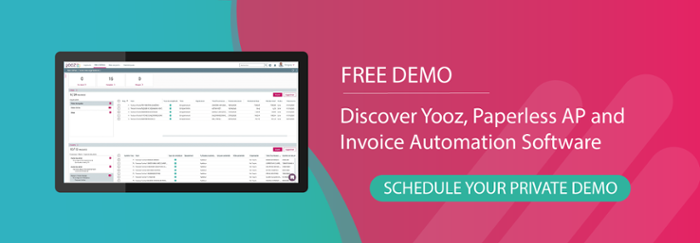Leave it to The Economist to find a succinct description of what the division of labor between man and intelligent systems will look like in the future. “Machines will do the nasty jobs; human beings the nice ones,” is how the renowned magazine recently paraphrased the future of work, dispelling fears of robots taking over our jobs from factory floors to offices. [1]
This mutually beneficial collaboration is the hallmark of a successful digital transformation that can make blue- and white-collar workers more productive, efficient, and boost overall job satisfaction. There is simply a huge number of high-value tasks that employees can do if only their hands and heads are free to focus on them.
Consider financial services - banking and otherwise - where the use of digital technology and cloud-based platforms are upending decades-old practices while adding more speed, savings, and security to the mix. The accounts payable function in particular is ripe for and receiving much more attention when it comes to technology upgrades and new digital applications. The goal is to replace oodles of paper records with a smooth business process on your screen, no matter how big or small.
Four Ways Digital Solutions Revolutionize Financial Services
Consider an accounts payable software platform that streamlines the entire purchase-to-pay workflow for business in any sector (after all, everybody has a financial process). There are four key benefits to embarking on and use of this kind of digitalization strategy:
An Unmatched All-in-One Solution.
This type of digital platform lets businesses of any size and in any industry capture, review, approve, and pay invoices under a single umbrella anytime, from anywhere.
Unlock savings and new revenue streams.
Intelligent software does away with delays and late payments. Instead, you can cash in on early pay discounts and even earn cash back using virtual cards.
Fast and Intuitive.
No more phone tag with vendors and other departments to clear up questions. Instead, answering questions and providing support is at your fingertips, benefitting both customer and user. In addition, a modern digital platform such as Yooz can onboard vendors with a single email address and even has a one-click solution to choose from a variety of payment methods (virtual card, ACH, eCheck or paper check).
Full Control and Security.
A cloud-based platform offers a fully secure digital roadmap that records every step and creates a detailed digital audit trail for your ERP or financial solution. Your information is kept in-house, further increasing the security.
Tell Me More About Speed and Savings
Consumers are already used to lean and fast financial services. Apps, not only from their banks, let them set up payees, review documents and pay with their face, their fingerprint, or other means. Enterprises, too, are moving away from handling paper, increasing service speed and decreasing costs associated with office supplies and storage.
It’s worth remembering that it costs, on average, north of $12 to process a single invoice, from opening an envelope to scanning or manually keying in the data, moving it along for review and approval, sending out payments and finally archiving the relevant documents and reconciling them with an ERP or financial software. Automation can shave 80% or more off this significant cost factor in the back office. Good riddance to the hole puncher and stapler!
What’s more, cycle times in the AP function drop from weeks to days or even hours, in many instances empowering organizations to pay invoices the same day. That’s particularly true when a business is struggling with thinned out staff, work-from-home mandates, or hybrid work models.
Cutting-Edge Tech Supercharges the Financial Services Industry
If everything runs digitally, team members can review and approve forms from anywhere. For example, pulling up related POs from their tablet while lying on the couch and even perform keyword searches across all data just as you would entering words into an internet search bar.
The key technologies that make this possible are artificial intelligence (AI) and its subset of machine learning (ML) as well as powerful Big Data software. Combined, they drive a more agile environment by enabling you to find as many needles in a haystack as necessary, see patterns, and act on them to drive strategic decisions that benefit not only the AP function but the entire organization.
AI and machine learning are not going to replace jobs but will rather enhance them. The finance function, to be sure, will always need an element of manual touch, for example when something is flagged for missing, inaccurate, or conflicting information. Software that continuously learns from large data sets can perform the basic checks on hundreds of tens of thousands of documents much faster than any person and then escalate the outliers among them for review.
Data Runs the World and Your Financial Processes Provides Not-So-Secret Intel
You don’t need to think of magic robots in Hollywood movies to appreciate the power that comes with digital technology and the ability to automatically pull data and relevant info from text and images on a document. It’s happening right here and now in the finance function of many businesses. Yooz, for instance, has seen and read more than 100 million invoices from thousands of vendors and along the way learned the idiosyncrasies of the various templates.
That information can be used to promote good such a streamlined process, easy audit support, complete business records. It can also be used to prevent the bad such as errors or deliberate fraud. AP automation will flag a duplicates with the same or slightly different invoice number, then alert the designated person to check it or provide last-minute updates or changes. After all, it's a partnership and not dictatorship.
How Man and the Machine Work Together to Transform Financial Services
But the partnership doesn't just stop there. Company financial teams will train and maintain the machine learning algorithms to become more accurate and powerful over time. Every document they read and "understand" increases their digitalized firepower.
For AP software platforms, this give-and-take starts with setting up flexible and customized digital workflows which are dedicated to your organization and fit its specific needs. As you keep using those workflows, AI begins to learn from your modifications, edits, changes, and choices. It will detect patterns and add them to its knowledge base.
No solution is perfect, so employees will always have to ensure that their machine learning systems are functioning properly, safely, and responsibly. Technology is either rules-based or needs to develop new rules as time goes on, but in many cases it’s a judgment call that only experienced employees can make.
Automation Lets the Financial Services Industry Attract More Top Talent
If a system provides the right information at the right time, it not only improves efficiency but also creativity. Once finance pros know they can ask any question of their data, an efficient process lets them come up with entirely new ways to look at things like business cash flow and cash management. Digitalization provides a business with the ability to address needs that you didn't even know existed.
And, while the jury is still out if the so-called “Great Resignation” is here to stay, many companies are focusing on hiring and retaining top talent. Implementing a technology solution will help them reduce the burdensome, repetitious aspects of the accounts payable work process for an overall better employee experience and new opportunities to interact with both staff and customers. Questions get answered faster, insights are shared in a better (more complete) way.
Reimagining Your Financial Business
Automation has a lot to offer when it comes to improving current processes however the possibilities of digital technology also opens new pathways to reimagine your business.
For example, consider YoozPay, an add-on module to the Yooz platform. While on the face of it, it’s about making payments as easy, quick, and secure as possible, it has the additional benefit of bringing vendors into a dynamic business network. With a single email they are onboarded onto the digital platform and become part of a web of financial business intelligence. One click creates more visibility and a better relationship for all, a key asset for uncertain times where new supply chain shocks are looming.
This is just one example. Fact is, working with intelligent accounts payable software goes far deeper than ensuring the business pays invoices on time. Advanced technologies help you reimagine the way that you run your business, yielding more flexibility, speed, and scale to always get more done with less. When an organization deploys a financial automation solution consisting of optical character recognition and smart data extraction powered by AI and machine learning, it can build a completely customized workflow that reflects team structure and their invoice and payment processing needs.
Financial Services Industry 2.0: Humans Will Stay in the Loop
Humans are crucial to get the most out of the technology set-up and avoid a cookie-cutter approach. At Yooz, for instance, Customer Success Managers work closely with each client throughout the implementation stage to first determine their specific needs and the most efficient workflow for them. One example are exceptions: You determine what happens with them, whether to skip escalation automatically or manually. Or take periods of time when an employee is absent. Humans can turn the knobs and temporarily change the approval workflow to avoid delays.
The same is true for the speed to get things done. Digital solutions for financial services will reduce the time spent on manual tasks like data entry, accelerate invoice and payment processing time to hours and detect fraud faster.
Getting Ready for Growth
Scaling up is no longer a headache but an opportunity to reinvent your business for growth. Minimizing human manual interactions with documents will free your team to focus on more value-added tasks or personalized services such as managing relationships with vendors. Technology provides an opportunity for any business to do more with the existing staff and resources as well as be able to adjust as it grows.
Decision making, finally, also benefits from digital transformation. Having real-time and accurate data on your screen empowers everyone to make better-informed strategic decisions, starting with, but not limited to, an organization’s cash flow.
“Fintech” has become a buzzword for the broad and deep changes sweeping the financial services digital landscape, as a Google search with 102 million results will confirm. Yet it is important to remember that software systems, no matter how powerful and advanced they seem, are not a magic bullet.
Finding the Right Balance of Man/Machine Collaboration
Just as I first mentioned, the future division of labor between humans and intelligent systems isn't simply a clear-cut "them versus us." What counts is finding and then fine-tuning the right balance of collaboration between humans and cutting-edge technology. Intelligent AP automation is a prime example that financial technologies will not take away jobs or replace humans. Instead, it helps businesses do more, better.
Or, as The Economist concluded after listening to top robotics and automation experts: “Instead of destroying jobs, robots can create them by making businesses more efficient, allowing firms to expand.”
Curious to find out more about how humans and technology can collaborate in financial services? Check out the reply of our live webinar at your convenience.







